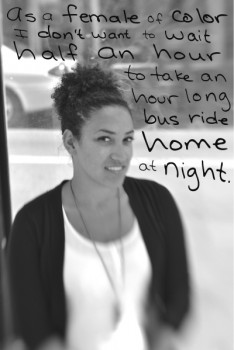HOW PORTLAND'S CREATIVE LAUREATE HELPS PUT A HUMAN FACE ON POVERTY STATISTICS
GRIM STATISTICS ABOUT POVERTY, SHODDY HOUSING, AND BLEAK OPPORTUNITIES MAY NOT MEAN MUCH UNTIL YOU KNOW THE STORY BEHIND THEM. WHICH IS WHY PORTLAND'S CREATIVE LAUREATE IS EMPHASIZING STORYTELLING IN SOCIAL JUSTICE.
BY DAVID ZAX - Fast Company Contributor
Link to Original Article
Julie Keefe gets people talking.
You don’t need to be a habitué of a certain Craigslist section to know that missed connections are everywhere. How many times have you failed to work up the nerve to say hi to a friendly-seeming neighbor? How many times have you wanted to ask the subway performer his life story, but got shy? How many times have you wondered whether someone in another department at your company has the skills to complement your ideas (or vice versa)? How much human capital is wasted simply by our timidity, our excessive politeness, or whatever it is that so often drives us to not talk to each other?
Questions like these animate the work of Keefe, Portland, Oregon’s first “creative laureate.” Born in Iowa, she settled in Portland in the mid-'80s and began doing freelance photography work for a local African-American newspaper. Artist, amateur sociologist, and flâneuse among the underprivileged, Keefe built a local reputation over the years (more on that in this excellent Oregonian profile), launching a project called “Hello, Neighbor” in 2007. With “Hello, Neighbor,” Keefe taught children to interview and photograph their neighbors. She was driven to create the project upon reading a quote in a newspaper about gentrification: a local activist said he didn’t mind the safer streets, but it pained him that with the influx of gentrifiers, it seemed people just weren’t saying hello to their neighbors anymore.
Since being named one of Fast Company’s Most Creative People earlier this year, Keefe has been busy. Her latest project expands upon the “Hello, Neighbor” concept. A Portland group called the Coalition for a Livable Future has put together something it calls an Equity Atlas, spotlighting issues of inequality throughout the region.
Keefe joined forces with the coalition to bring her special mix of conversation-fostering and picture-making to the program. Among the disparities her and the coalition’s work has illuminated are issues of housing, transit, air quality, and poverty. Keefe spent four months on the project, wrapping it up in October; she debuts some of the images the project produced in the slide show above.
What does Keefe’s work achieve, when it’s at her best? She refers to one of the “golden moments” of the project. A homeless or recently homeless woman named Katrina blazed into one Equity Atlas event, tough and hardened. “The way she presented herself when I first saw her was with this great bravado, a sassy woman among men,” recalls Keefe. Here was a woman with her defenses up, a woman it would surely be difficult to know. And yet Katrina was paired with another woman for the interviewing and portrait-making, and soon, the act of telling her story had caused her to open up. Indeed, in a short span of time, she had made herself vulnerable, and left a lasting impression on those around her. “I won’t ever forget her,” says Keefe. “And I met her for all of an hour and a half.” Her image--visibly softened from the Katrina that Keefe describes of a mere hour and a half before--is above.
A roving community art project like this may tug at the heartstrings--but does it have anything to do with business? Keefe asserts that it does. She has already begun to teach her “Hello, Neighbor” technique of photography and interviewing at business leadership forums; the same practice that fosters community at a homeless shelter can build teams in your organization, she posits. “Storytelling is a really important connector, no matter what level of society you happen to reside in,” she says.

She says that “Hello, Neighbor”-style conferences can be used to help get engineers to talk to design people at a tech company, for instance, or for the collective “left brain” of an organization to connect with its collective “right brain.”
“Conversations that break down walls on a non-business level boost creativity," she says. I know that it works--I’ve seen it work. One of the things we’re missing in this society is keeping in touch with humanity even though there are more social networks. I think real conversation is missing.” What’s lost, when a conversation between two people is missed? “Understanding the capacity for both of you to accomplish something that isn’t mandated,” says Keefe.
“Trust builds community,” she goes on, “and I think you can strengthen anything from a nonprofit that’s supposed to be touchy-feely but often isn’t, to, you know, Nike. In Fortune 500 companies, the impulse is often not to let your guard down. And yet a project like this can illustrate how conversation isn’t necessarily ‘letting your guard down’--it’s an exchange of ideas that can be beneficial for both parties.”
[Photos courtesy of Julie Keefe | Participants in the Equity Atlas Storytelling Project]
